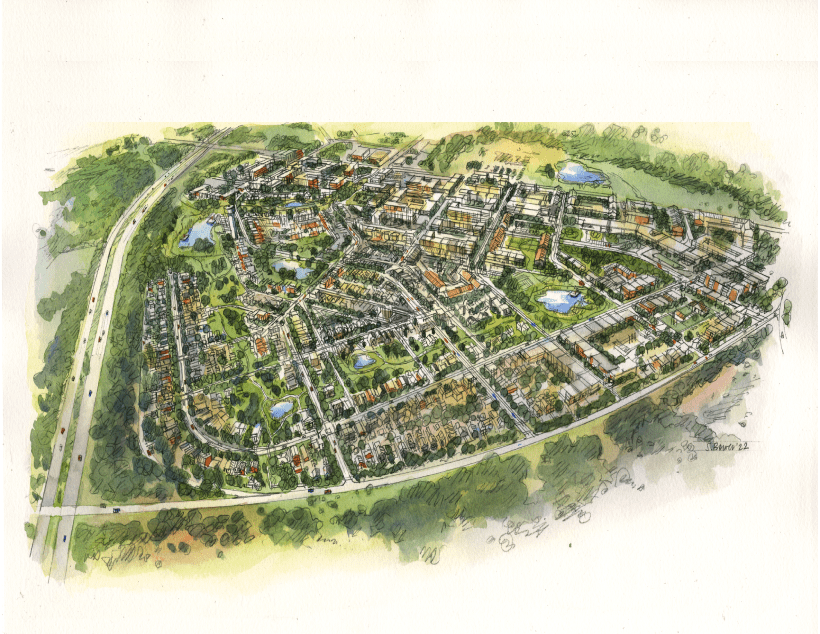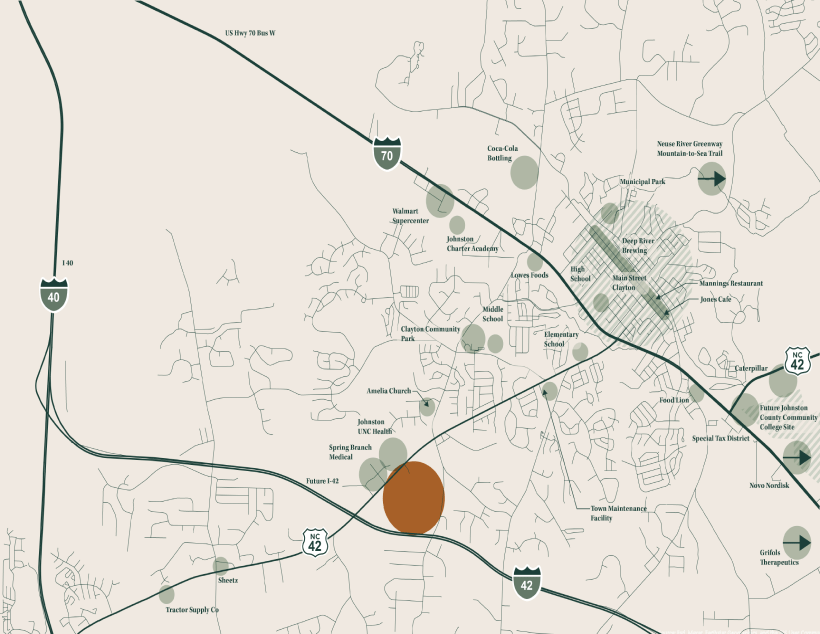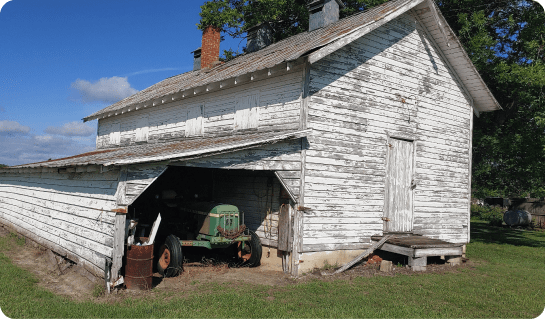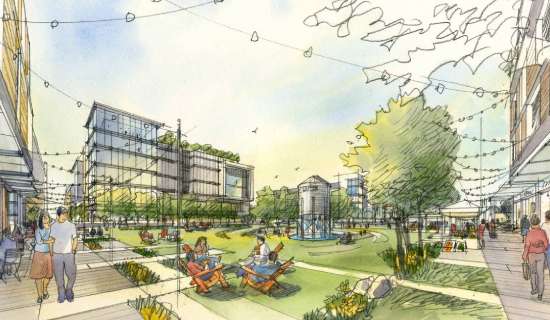We’re honoring history while minting a new legacy.
Nestled amid pristine North Carolina landscapes, the District shares an intimate connection with the native landscape that truly defines its character. The Copper District’s naturalistic design honors existing ecosystems and preserves the land’s most beautiful natural assets – allowing us to celebrate them as dynamic spaces connected through miles of trails.
Preserving Penny Farm and our rural roots.
The Copper District preserves an important thread of Clayton’s history, which dates to the 1800s when the town was a major market for cotton. Threatened by the Great Depression and to re-energize the economy, Clayton introduced programs that spurred new farms over the next decade.
One of these new farms was settled in 1938 by the Penny family, and this became the land chosen for the Copper District. Here the naturalistic character celebrates the Penny family and the many other families whose farms and customs were the foundation of this community.
Precedents looked to for guidance and ideas.
The Copper District follows a growing movement of new towns that have successfully integrated the natural environment and elements of agriculture into community life. Harvest, in Northlake, Texas, and Serenbe, in Chattahoochee Hills, Georgia, are prime examples of neighborhoods where an emphasis on the environment can be used to establish contemporary, sustainable lifestyles. For a local example, look no further than North Hills in Raleigh, North Carolina, a development that has blossomed into a much sought out and bustling live, work, shop, dine, and play destination.

The optimal location to capture national and regional momentum.
“The Copper District is going to benefit the area by being the front door to Clayton...family, friends, loved ones are going to be able to see that you can stay and play right there in Clayton.”
An unmatched crossroads with limitless access.
The potential for the Copper District is boundless. Before the end of the decade, it will become a critical crossroads connecting Raleigh, one of the nation’s fastest growing and most promising regions, with I-95 and the resources of the entire eastern region.
In the next decade, significant infrastructure investments will make Clayton one of the most central, connected, and accessible destinations along the East Coast. The Interstate 540 loop – the premiere connection across the Research Triangle region – will soon complete its final southern portion, linking Clayton to pivotal regional assets.
At the same time, the US Hwy 70 Bypass’ upgrade to Interstate 42 will bring with it interstate standards that ensure that Clayton will be an important junction connecting several high-volume routes.
US Highway 70 Bypass/Future I-42 is one of the principal east-west corridors across eastern North Carolina, but more importantly, it connects the state to Interstate 95, which is the primary north-south interstate highway on the East Coast. And I-95 extends from Maine to Florida and joins several of our nation’s largest population centers and economic hubs.
- Downtown Clayton-7 minutes
- Downtown Raleigh-20 minutes
- statuette campus-21 minutes
- rdu international airport-30 minutes
- research triangle park – 32 minutes
- Downtown cary -28 minutes
- Downtown durham-40 minutes
- the coast- 1 hour and 30 minutes
A new gateway and perfect complement to downtown Clayton.
With Clayton’s continual and expected growth in the coming decades, the Copper District is the most appropriate location for planning and capturing new development demands. Clayton’s downtown offers a special spirit that can’t, and shouldn’t be, replicated. The Copper District serves as a perfect complement to downtown Clayton and is a key location to accept new growth in formats otherwise not feasible.

Smart growth that focuses community assets into smaller clusters.
Clayton’s Comprehensive Plan recognizes that growth is inevitable and calls for “smart growth” – strategies that organize, enable, and regulate growth to take advantage of its benefits and mitigate risks.
It proposes the creation of mixed-use community nodes that focus investments, amenities, and daily necessities into smaller clusters, thereby promoting pedestrian activity within a lively setting.
In this way, growth delivers beneficial community assets like schools and parks that all can share. The Copper District has a unique footing to bring together these elements to shape these highly sought-after walkable communities on behalf of existing and future residents alike.

COPPER DISTRICT SITS AS A WELCOMING FRONT DOOR.
Located adjacent to the interchange that will be Clayton’s most significant access point, the Copper District sits as the new front door to the area on a highly visible and accessible site that must be treated with care. As I-42 is realized, this unique gateway will be a distinctive link that strategically connects the traditional and contemporary facets of the town unlike anywhere else.

A WEALTH OF UNTAPPED OPPORTUNITIES.
Still just minutes away from the notable conveniences of the Research Triangle region – including distinguished educational institutions, celebrated cultural landmarks, and diverse entertainment options – the Copper District is a rare destination that provides both connections to city life and a retreat from its busy demands, while laying its head at the front door of the culture and community of Clayton. The balance is simply unmatched.


